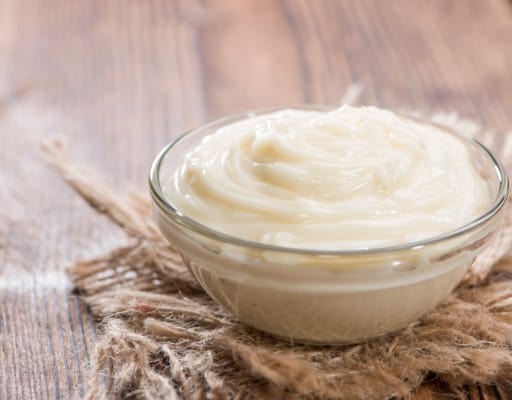If you’ve ever attempted to make your own mayonnaise at home, only to end up with a runny mixture instead of the creamy, luscious spread you were aiming for, you’re not alone.
A runny Mayo is quite a frequent problem when making mayonnaise. Its cause is simple but the fix can be quite tricky.
Keep reading to find out all the how’s of salvaging a broken homemade mayonnaise.

What Is A Runny Mayonnaise? And Why Does It Happen?
A runny mayonnaise happens when a mayo hasn’t reached its desired thickness and creamy consistency, but rather, remains thin and watery, and fails to hold its shape or adhere to other ingredients as it should.
The primary reason for runny mayonnaise is a failed emulsification process, where the two immiscible liquids oil and water (or in this case, oil and vinegar or lemon juice), fail to come together and stabilize. And this is especially common when making mayonnaise with an immersion blender.
There are several factors that can lead to a failed emulsification process and therefore a runny mayonnaise.
For example, adding the oil too quickly rather than in little drops, followed by a thin steady stream later on, and also using ingredients such as yolks and oil at different temperatures.
Lack of whisking consistently and in a pattern (as you add the oil into the egg mixture) can also contribute to a runny mayo, and when using an immersion blender, not allowing for the emulsion to begin at the bottom before gradually lifting the blender upwards can be a cause too.
And lastly, using yolks that are of poor quality (which may contain less lecithin) can make it more challenging to achieve a stable emulsion.
Is It Okay To Eat Runny Mayonnaise?
A runny mayonnaise simply indicates that the emulsification process didn’t work as intended, but it doesn’t necessarily mean that the mixture has gone bad or is harmful to consume.
You can actually use a runny mayonnaise in soups or sauces or as a marinade, or in recipes that require cooking, but don’t ever purpose it in recipes that require you to taste the Mayo in its raw state, like salad dressing or spread. It wont work well, if you used unpasteurized eggs, could increase the risks of food borne illness.
But, and a big but… Why consume or look for ways to consume a runny mayonnaise when they are things you can actually do to salvage the situation?
Read below to find out how to fix a watery mayonnaise.
How To Fix Watery Or Runny Mayonnaise
If for some reason you ended up with a mayonnaise that is runny, then there are things you can try to salvage the situation.
Blender Fix
In a clean blender, add one whole egg and a yolk, and blend together on low speed to incorporate everything. Now gradually add the runny mayonnaise into the blender at low speed until everything comes together and becomes thick and creamy.
Hand Fix
Instead of a blender, we can use our hands to fix a runny mayonnaise.
In the same manner, break one whole egg and a yolk and mix everything together using a whisk in a small bowl. Or you can use one egg yolk to prevent an eggy Mayo.
Now gradually add the runny mayo into the egg mixture and whisk it using a fork or whisk in a certain pattern until the mayo comes together.
It is very important to go slowly with the addition of running mayo to avoid causing it to break again.
Fresh Mayo Fix
Another way you can fix a runny mayonnaise is by creating a small fresh batch of mayo and then adding it into the batch of runny mayo and incorporating it using an immersion blender.
Now this is a much difficult route to follow because it will involve you making a fresh batch of mayonnaise, but anything to salvage our broken batch right?
It is very important that you allow the mayonnaise to begin to incorporate from the bottom (which is why it is very important to use a transparent container), before you begin lifting up the immersion blender to incorporate the rest of the mixture.
Immersion Blender Fix
If you have a runny badge of mayo, probably one that you made an immersion blender or using any other method, get into the a container, add one egg yolk, trap it with the immersion blender at the bottom, and begin to blend at low speed making sure an emulsion occurs at the bottom first before lifting the immersion blender to higher areas.
How To Prevent Runny Mayo
They are key things you can do to prevent a runny mayonnaise from happening in the first place, here they are.
- Always follow the recipe instructions as they are written. Deviating from the recommended proportions or methods can cause the emulsion to break and lead to a runny mayonnaise.
- When making Mayo, it is very crucial to use room temperature ingredients, especially the eggs and oil, as this would ensure a more stable emulsion.
- If you’re using an immersion blender, let the emulsion begin at the bottom of the jar or container first. Once you see the emulsion forming, slowly lift the blender up to incorporate the rest of the oil.
- When making mayonnaise by hand, whisk vigorously and continuously in a single pattern.
- Start by adding the oil in small drops at first, and as the emulsion begins to form, gradually increase the flow of oil to a steady stream. Adding the oil too quickly can break the emulsion and result in runny mayonnaise.
- Always use fresh eggs as they provide better emulsifying properties than older ones.
Frequently Asked Questions
What To Do With Failed Mayonnaise?
If your mayonnaise has separated, broken or turned out runny, don’t throw it away! You can try to salvage it by slowly whisking it into a new egg yolk, a drop at a time.
But if you think that is too much work for you, then use the failed mayonnaise in soups, sauces or as a marinade.
Don’t use it as a spread or in a recipes where the consistency of the Mayo is crucial to the success of the dish, as it might not work, or taste great.
What Do I Do If My Homemade Mayo Is Too Oily?
If your homemade mayonnaise is too oily, you can try to fix it by whisking in a small amount of water or lemon juice (about 1 to 2 teaspoons). It will return thin, but less oily, and then you can continue to add the rest of the Mayo. If it’s still too oily, you can attempt to rescue it by slowly whisking the oily mayo into a new egg yolk.
Can You Thicken Mayonnaise With Cornstarch?
It is not recommended to thicken mayonnaise with cornstarch as it can alter the taste and texture of your mayo. The key to achieving the right consistency in Mayo is following the proper emulsification techniques and maintaining the right balance of ingredients.
Why Do You Add Oil Slowly To Mayonnaise?
Adding oil slowly to the mayonnaise is crucial for creating a stable emulsion. If you add the oil too quickly, it can overwhelm the egg yolk’s emulsifying properties and cause the mixture to separate and become runny.
Does Mayo Get Thicker In The Fridge?
Yes, mayonnaise tends to thicken slightly in the refrigerator. The reason is because the cold temperature causes the oil and other ingredients to solidify, resulting in a thicker texture.
If a runny mayo is the reason why you’re asking that, then don’t bother as your runny Mayo won’t be salvaged by putting it in the refrigerator.
The only solution is what we have discussed above, or to use the runny Mayo as it is.
Is Mayonnaise Still Good If The Oil Separates?
If your mayonnaise has separated, it’s not ideal for use as a spread or dip although you can still safely consume it. The best purpose for it is as a base for salad dressings, marinades or sauces. You can also try to salvage the separated mayonnaise by following the rescue methods mentioned earlier.

